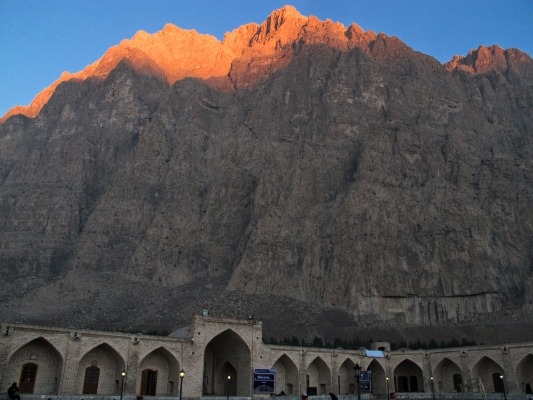Bisotun
Bisotun formerly known as Behistun or Bistun is an ancient archaeological site located in Kermanshah province in the west of Iran. Bisotun derived from the word “Bagastana” in Old Persian which means “the place of God”.
Bisotun refers to a mountain close to the ancient trade route which links Iran Plateau to Mesopotamia. This is one of the ancient sites with features from prehistoric times to Median, Achaemenid and Sassanid periods. What makes this site so valuable and more important is a multilingual inscription and a large rock relief on a cliff at Bisotun Mountain was ordered by Darius the Great between 522-486 BC, when he came to the throne of Persian Empire.

The inscription has been written in 3 different cuneiform script languages which are Old Persian, Elamite, and Babylonian (roots from Akkadian).
Bisotun Wall- Bisotun Mountain
Bisotun is a vertical rock formation in Kermanshah province, west of Iran in the Zagros Mountain range. This limestone rock in the tallest face is about 1200 m from base to summit and it’s one of the most famous targets for rock climbing in Iran. Bisotun is known as one of the hugest rocks in the world. This rocky Munster has 5km in width. Although it isn’t a monolith wall because of three ledges at the middle but it’s height and breadth has made it a marvelous project for rock climbers. South face of Bisotun is wall side and from east to west there are lots of various named climbing routes. Since first ascent of Bisotun wall was made in 1969 by an Iranian team, many climbing routes have been opened on different parts of Bisotun, including trad and sport multi-pitch routes. One of the privileges of Bisotun is various climbing routes in wide range of difficulty grading. Beside of easy routes like 6a/b, there are some moderate routes and also difficult routes like (Piton 8a), (Festival 7b), and (Kajdom 8b+?) which have been opened in recent years. Some of old routes those go to the top are very long and in the past, climbers have made a shelter in the middle way to stay for night and climb to the top in next day. You can see the shelters in some routes. The elevation of the summit is 2800 m from sea level and this is accessible by hiking from out of the wall. Bisotun is also well-known worldwide because it has been hosted four international rock climbing festivals in 2011, 2013, 2015, and 2019. Bisotun has been used for BASE JUMPING as well. Geraldine Fasnacht from Switzerland made the first BASE JUMP from Bisotun in 2011 in the first festival. Next year, other Base Jumpers from Iran and other countries made successful jumps from Bisotun. If you are a rock climber and if you seek experience climbing on a huge fantastic rock, we suggest you don’t miss Bisotun. Zino Expedition team can organize your climbing tour in Bisotun including all necessary services and an expert climbing guide who knows the area very well and also tailormade this trip considering to your request.
Best season
If you want to travel to Iran to climb Bisotun There are two ideal periods of time during the year. The first begins from early March to the end of May. At this time there is longer daylight. After that weather will get warm and dry till the end of summer. The next proper time for Bisotun starts from early October to the end of December.
Activities
Rock climbing ( big wall and sport climbing ), Base Jumping, Highlining, Paragliding.
